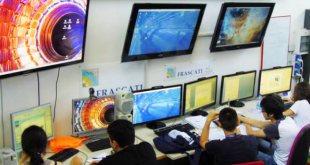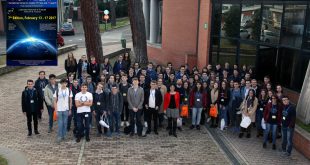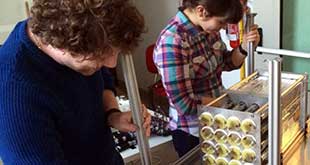The 3rd of April, for the first time, the Laboratory will open its doors to students attending their last year of high school, for a whole day dedicated to an orientation towards STEM careers – Science, Technology, Engineering and Mathematics. Students will learn more about the activities of professionals in the fields of Research, University and High Technology Industries. They will have a chance to meet young researchers and technologists and to visit the main LNF experiments.
Read More »News
International masterclass 2017 @LNF
From the 13th to the 17th of March 2017, the LNF will host the 13th edition of IPPOG-International Particle Physics Masterclass, addressed to students in their last year of high school. The 52 Italian students will attend lectures on the Standard Model, detectors and particle accelerators, followed by computer exercises on LHCb and CMS experiments from the LHC particle accelerator.
Read More »Searching for Dark Photons across the Atlantic
A group of Cornell Laboratory for Accelerator-based Sciences and Education (CLASSE) physicists, coming from Cornell University, Ithaca, New York, USA, went to BTF at the National Laboratory of Frascati to develop a new detector with capabilities to chase a new possible particle: dark photon, one possible manifestation of dark matter, potentially produced in electron-positron annihilations.
Read More »70 High school students at INSPYRE 2017
From February 13th to the 17th, the National Laboratory of Frascati is hosting the 7th edition of INSPYRE – International School on Modern Physics and Research. This year the topic of this international school for High School students from all over Europe is the Space Frontier.
Read More »DAFNE collider defines its time horizon
The LNF Scientific Committee held last November has discussed the schedule for DAFNE operation in years 2017-2019.
Read More »Quark-antiquark pairs modify the electromagnetic interaction
The KLOE-2 collaboration, analysing the data collected at the DAFNE Collider, has measured the running of the electromagnetic coupling constant (alpha) as a function of the energy.
Read More »Gihan Kamel: from DAFNE to SESAME
Gihan Kamel, the only woman in the scientific staff of SESAME, studied in Italy before getting to the particle accelerator that is going to start running in a few weeks in Jordan.
Read More »Beam Test Facility calls for scientists in 2017
The Beam Test Facility, extracting electron and positron beam pulses from DAFNE’s LINAC, has been operational in 2016 providing 240 beam-days, and it will stop for the winter shut-down on Dec. 19th.
Read More »2017 SXT Contest
ScienzaPerTutti launches their 2017 contest, focused on the topic of the Infinite
Read More »LNF 2017 Educational program: meet Science!
The National Laboratory of Frascati’s yearly program, Educational, will start again in January 2017, featuring a wide range of activities designed for Students, Teachers and General Public.
Read More » INFN-LNF Laboratori Nazionali di Frascati
INFN-LNF Laboratori Nazionali di Frascati









